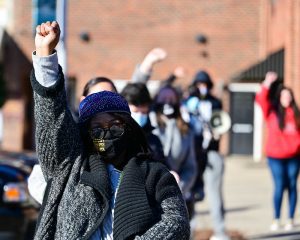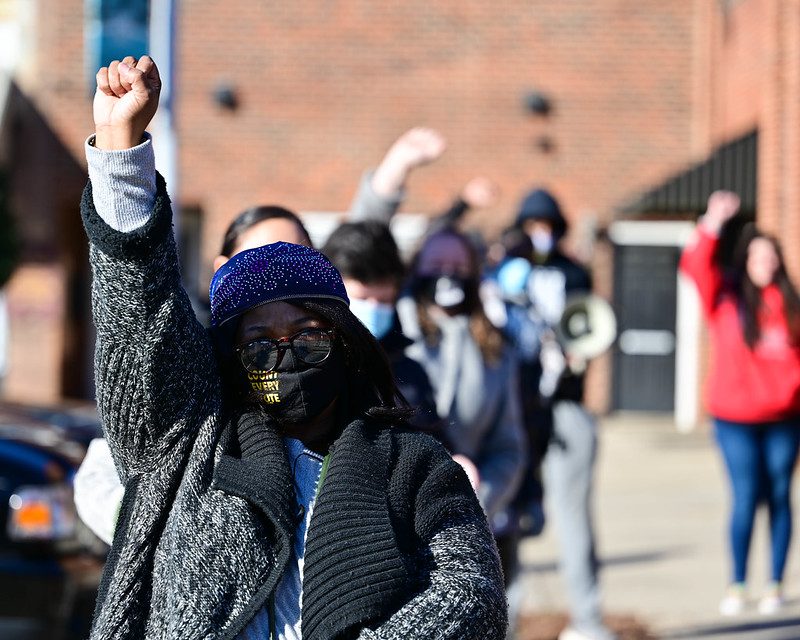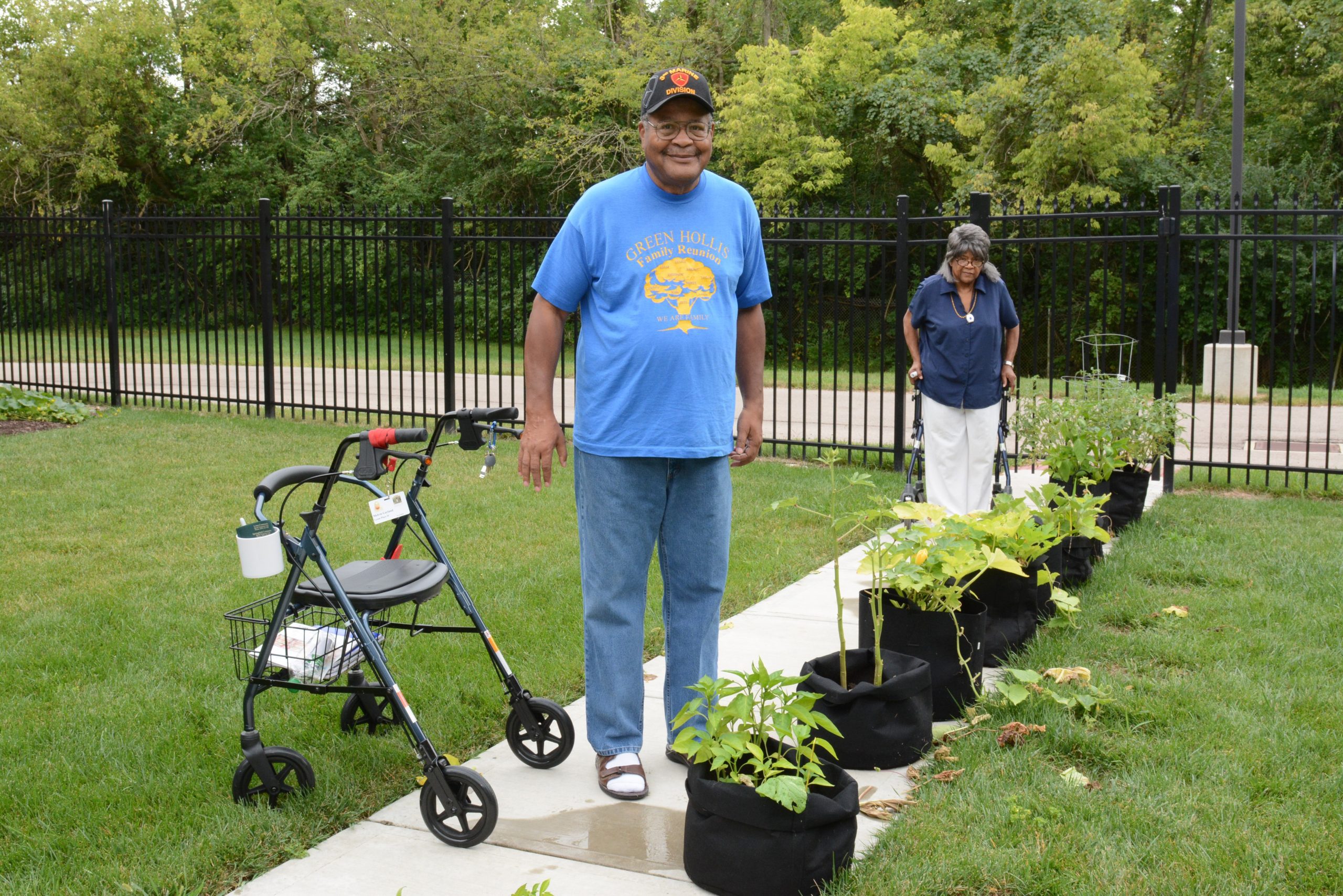
A rent relief protest in North Carolina earlier this year. Photo by Anthony Crider, CC BY 2.0
Long before the COVID-19 pandemic, Black, Latino, and Native American renters faced disproportionately high rent burdens and housing instability. The pandemic has magnified these disparities as workers of color disproportionately work in the industries and occupations that saw the greatest job losses, and communities of color experienced the highest COVID hospitalization rates. While the recently passed coronavirus relief packages promise to provide critical help to many struggling renters, program administrators will need to make explicit efforts to ensure that this assistance reaches communities of color with high levels of need. Without such efforts, some groups will fall through the cracks as some tenants never get any information about the program, have uncooperative landlords, are hesitant to start or unable to complete complicated applications, or cannot provide the full set of required documentation. Take-up of social programs often falls short of need, and this is especially true for vulnerable groups. Emergency rental assistance is no exception.
Yet as a field, we pay far less attention to take-up and its equity implications than we should.
Drawing on both a survey of 220 “first-generation” COVID emergency rental assistance programs (about one-third of the roughly 530 local programs and 90 state or regional programs funded via the CARES Act and other sources), and interviews with selected program administrators, the NYU Furman Center, the Housing Initiative at Penn, and the National Low Income Housing Coalition—where we work— recently released a report outlining steps that localities can take to advance racial equity in their programs. Here we highlight five of those key lessons.
Prioritize Vulnerable Groups in Program Guidelines
One key step that programs can take to advance racial equity is to set selection criteria to prioritize vulnerable populations for assistance. Such priorities can help ensure that limited funding reaches those most in need, many of whom are households of color. About half of the programs we surveyed created priority groups (usually very low-income households and families with children) from all eligible households for the distribution of assistance. The new funding for emergency rental assistance enacted by Congress in December 2020 requires programs to prioritize renters with very low incomes and those who have been unemployed for at least 90 days. Programs can prioritize additional populations.
Localities might consider prioritizing applications from households that have fewer assets or those that live in disadvantaged census tracts. Programs can achieve prioritization in a variety of ways, including setting aside a specific share of funds for specific populations, providing assistance first to specific populations, or implementing a weighted lottery system for distributing assistance when resources are insufficient to meet all tenants’ needs. For example, Philadelphia’s COVID-19 Emergency Rental Assistance (CERA) program used a weighted lottery to allocate available assistance with a certain number of “seats” reserved for households located in high-poverty census tracts (those with poverty rates at or above 25 percent) and for families with children. The lottery was then calibrated to prioritize high-poverty ZIP codes and families with children. Similarly, cities might consider prioritizing small-building owners, who are less likely to have the resources needed to manage long periods of non-payment and are more likely to be people of color.
Invest in Outreach and Targeting
The importance of investing in outreach and targeting was another clear lesson from early emergency rental assistance programs. The program administrators we interviewed reported particular difficulty reaching residents who were wary of government assistance due to mistrust or fear of stigma, as well as communities isolated by geography, language differences, or limited access to technology. Program administrators needed to be especially creative in designing effective outreach strategies in the face of COVID-related shutdowns to increase awareness of their programs, build trust, and address barriers to applying. Many program administrators found that working with trusted community partners greatly helped in outreach efforts.
[Related Article: During the Pandemic, Community Development Organizations Prioritize Relief and Assistance Work]
Chicago offers a good example of how programs can effectively target hard-to-reach populations. After struggling to get immigrant populations to apply via online applications in their first round of rental assistance in 2020, the city extended efforts to select partner organizations with ties to these communities to bring applicants into the program and process their applications. In doing so, the city found their partner organizations were better than the city’s online portal at reaching and serving these marginalized groups.
Simplify Applications and Documentation
Perhaps the most important barrier identified in our survey was the documentation required of applicants, which was determined by program administrators’ interpretation of funding guidelines. Most programs required renters to provide documentation of income and a current lease, and many also required other documents such as a driver’s license or state ID, a Social Security number, or proof of COVID-related income loss. Stricter documentation requirements were correlated with more incomplete applications, and programs that required proof of COVID-related income losses reported more difficulty in obtaining completed applications. Perhaps most notably, virtually all programs we surveyed required proof of a current lease, which automatically disqualifies those with informal rental agreements.
Guidance from the U.S. Department of the Treasury regarding the Emergency Rental Assistance Program funded by the COVID-19 relief package, which some states and local jurisdictions are now distributing, allows some measure of self-certification by applicants of their COVID-related hardship, income, and rental arrears. To the extent possible, program administrators should take advantage of this flexibility with regard to documentation requirements.
Beyond documentation requirements, the applications themselves were often a barrier for applicants, including long and complicated sets of questions. Renters were more likely to complete applications with instructions that were simple, clear, and translated into multiple languages. Providing dedicated hotlines with application assistance and offering different ways to submit applications (electronically and in person) can help ensure that those with limited language skills, mobility, or technology can still apply.
Some cities are already taking strides toward more accessible applications. In California, San Leandro and Oakland are working with a nonprofit organization to help administer the application in both Spanish and English and with options to complete the application online, by phone, or via mail. Applicants in these localities also have the option to self-certify in lieu of providing documents, a significantly easier process for both applicants and administrators.
Some programs also made more hands-on assistance available to potential applicants, often asking community organizations to provide residents with application assistance. In Houston, Texas, for example, program funds are being distributed by BakerRipley and Catholic Charities of the Archdiocese of Galveston-Houston, two organizations with experience in helping families in need. To make the process as smooth as possible, the city has also organized a group of community agencies to serve as program navigators, helping people complete their applications. In general, our study found that localities who worked with nonprofits were less likely to report application incompleteness as a problem.
Collect Robust Data
Equitable rental assistance programs require data to monitor program outcomes in real time. Understanding the gender, age, race/ethnicity, and neighborhood demographics of both successful and unsuccessful applicants is critical in identifying gaps in assistance, and in understanding why certain applicants or groups of applicants are facing more challenges in successfully receiving assistance. Tracking outreach efforts against the applicant pool can provide administrators with a helpful gauge of which methods and strategies are successful in generating applications from hard-to-reach populations. Finally, tracking landlord participation and compliance with program requirements is crucial for ensuring that the funds serve their intended purpose: keeping tenants safely and stably housed.
Make Course Corrections
With sufficient data in hand, program administrators can tailor and adjust rental assistance programs to promote more equitable outcomes. Los Angeles provides a helpful example of strategically refining how its program worked. The city began to process applications for rental assistance in the late summer and it tracked how well applicants were making it through the application and disbursement process. By mid-fall the city discovered that 45 percent of qualified applicants who made it through the application process were still unable to access the benefit because of landlord nonresponse or because their landlord decided not to participate in the program. To prevent this from causing renters to miss out, the city began offering direct-to-tenant payments for those whose application was approved but whose landlord did not participate, which allowed all of the households in this group to access the rent relief. In another example, early data from a program in Utah showed that only 34 percent of approved applications originated from ZIP codes with the highest eviction rates. The state is now working to target outreach and case management efforts to these high-risk ZIP codes, in an effort to reduce disparities.
All too often, well-intentioned programs end up reinforcing existing disparities, as the most vulnerable fail to hear about available assistance or to overcome the administrative hurdles required to successfully apply. To be sure, COVID-related emergency assistance will not address the longstanding housing affordability challenges that so many renter households of color face. But we hope that the lessons here can help states and localities center equity in the design not only of their emergency rental assistance programs, but also of their full set of housing programs.






Comments